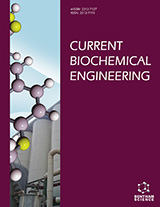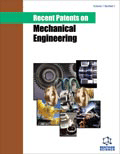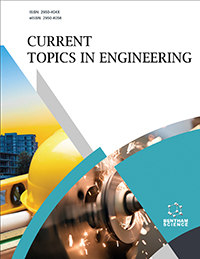Abstract
Novel membranes were fabricated from fungal chitosan (Cs) and starch based super absorbent polymer (SAP) for hemostatic application. The commercial production of Cs through alkaline deacetylation of crustacean chitin includes many drawbacks. Fungal Cs production, by a more eco-compatible technique, has become an alternative source for the traditional one. In this study, the production of fungal Cs was executed in a bioreactor from the mycelia of Absidia coerulea. The maximum obtained fungal Cs was 0.55 g/L after 48 h. The fabrication of Cs-SAP membranes was approached subsequently using two methods, physical blend of two polymers, and Cs-SAP sub-layer. To evaluate the homeostatic effect of Cs – SAP membranes on blood, erythrocyte sedimentation test was conducted in vitro. Since increasing the Cs concentration from 0.5 to 2 % w/v in the fabricated Cs – SAP membranes, reduces the erythrocyte sedimentation time from 69.8 to 62.3 min, respectively, while increasing the concentration of SAP (0.12-0.5 % w/v) has less or no significant effect on erythrocyte sedimentation time. Sub-layered 2L8 membrane significantly reduced ESR (P< 0.05) by 22%, while physically blended 11B8 membrane diminished ESR by only 12% compared to the control. Furthermore, these membranes were investigated by FT-IR, SEM, tensile, antimicrobial activity and cytotoxicity. Chitosan-SAP membranes can be described as bio-membranes with a homogeneous matrix, stable structure and interesting mechanical properties, with great possibilities of utilization in hemostasis.
Keywords: Biopolymers, fungal chitosan, hemostasis, mechanical properties, membranes, superabsorbent.
Current Biochemical Engineering (Discontinued)
Title:Fabrication and Characterization of Fungal Chitosan-SAP Membranes for Hemostatic Application
Volume: 1 Issue: 1
Author(s): Ahmed el-Mekawy, Hanaa M. Hegab, Ashraf el-Baz and Samuel M. Hudson
Affiliation:
Keywords: Biopolymers, fungal chitosan, hemostasis, mechanical properties, membranes, superabsorbent.
Abstract: Novel membranes were fabricated from fungal chitosan (Cs) and starch based super absorbent polymer (SAP) for hemostatic application. The commercial production of Cs through alkaline deacetylation of crustacean chitin includes many drawbacks. Fungal Cs production, by a more eco-compatible technique, has become an alternative source for the traditional one. In this study, the production of fungal Cs was executed in a bioreactor from the mycelia of Absidia coerulea. The maximum obtained fungal Cs was 0.55 g/L after 48 h. The fabrication of Cs-SAP membranes was approached subsequently using two methods, physical blend of two polymers, and Cs-SAP sub-layer. To evaluate the homeostatic effect of Cs – SAP membranes on blood, erythrocyte sedimentation test was conducted in vitro. Since increasing the Cs concentration from 0.5 to 2 % w/v in the fabricated Cs – SAP membranes, reduces the erythrocyte sedimentation time from 69.8 to 62.3 min, respectively, while increasing the concentration of SAP (0.12-0.5 % w/v) has less or no significant effect on erythrocyte sedimentation time. Sub-layered 2L8 membrane significantly reduced ESR (P< 0.05) by 22%, while physically blended 11B8 membrane diminished ESR by only 12% compared to the control. Furthermore, these membranes were investigated by FT-IR, SEM, tensile, antimicrobial activity and cytotoxicity. Chitosan-SAP membranes can be described as bio-membranes with a homogeneous matrix, stable structure and interesting mechanical properties, with great possibilities of utilization in hemostasis.
Export Options
About this article
Cite this article as:
el-Mekawy Ahmed, M. Hegab Hanaa, el-Baz Ashraf and M. Hudson Samuel, Fabrication and Characterization of Fungal Chitosan-SAP Membranes for Hemostatic Application, Current Biochemical Engineering (Discontinued) 2014; 1 (1) . https://dx.doi.org/10.2174/22127119113019990001
| DOI https://dx.doi.org/10.2174/22127119113019990001 |
Print ISSN 2212-7119 |
| Publisher Name Bentham Science Publisher |
Online ISSN 2212-7127 |
 20
20Related Articles
-
Transactivation of ErbB Receptors by Leptin in the Cardiovascular System: Mechanisms, Consequences and Target for Therapy
Current Pharmaceutical Design Radiopharmaceuticals Labelled with Copper Radionuclides: Clinical Results in Human Beings
Current Radiopharmaceuticals Oxidative stress in carcinogenesis: new synthetic compounds with dual effects upon free radicals and cancer.
Current Medicinal Chemistry New Insights into the Regulation of Liver Inflammation and Oxidative Stress
Mini-Reviews in Medicinal Chemistry Editorial (Thematic Issue: Emerging Immunotargets in Genitourinary Tumors)
Current Drug Targets Targeting Vascular Niche by Parathyroid Hormone
Current Medicinal Chemistry Vitamin D - Pivotal Nutraceutical in the Regulation of Cancer Metastasis and Angiogenesis
Current Medicinal Chemistry Cisplatin Properties in a Nanobiotechnological Approach to Cancer: A Mini-Review
Current Cancer Drug Targets Recombinant Interleukin-12 for Immunotherapy: A Double-Sided Sword
Current Medicinal Chemistry - Immunology, Endocrine & Metabolic Agents The Aryl Hydrocarbon Receptor Nuclear Translocator (ARNT) Family of Proteins: Transcriptional Modifiers with Multi-Functional Protein Interfaces
Current Molecular Medicine Thromboembolic Events in Patients Treated with Anti-Angiogenic Drugs
Current Vascular Pharmacology Finding Appropriate Signal Peptides for Secretory Production of Recombinant Glucarpidase: An <i>In Silico</i> Method
Recent Patents on Biotechnology Targeted Therapy for Advanced Prostate Cancer: Inhibition of the PI3K/Akt/mTOR Pathway
Current Cancer Drug Targets Targeting the Immune System in Cancer
Current Pharmaceutical Biotechnology Implications of Photophysical and Physicochemical Factors on Successful Application of Photodynamic Therapy
Current Pharmaceutical Design Kinase CK2 Inhibition: An Update
Current Medicinal Chemistry Review of PI3K/mTOR Inhibitors Entering Clinical Trials to Treat Triple Negative Breast Cancers
Recent Patents on Anti-Cancer Drug Discovery Biomarkers of Angiogenesis and their Role in Patient Selection for Antiangiogenic Therapy
Current Angiogenesis (Discontinued) Anti-Cancer Therapies that Utilize Cell Penetrating Peptides
Recent Patents on Anti-Cancer Drug Discovery Roles of Natural Compounds from Medicinal Plants in Cancer Treatment: Structure and Mode of Action at Molecular Level
Medicinal Chemistry

















